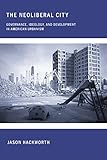The Neoliberal City : Governance, Ideology, and Development in American Urbanism / Jason Hackworth.
Material type: TextPublisher: Ithaca, NY : Cornell University Press, [2011]Copyright date: ©2013Description: 1 online resource (248 p.) : 11 tables, 27 charts/graphsContent type:
TextPublisher: Ithaca, NY : Cornell University Press, [2011]Copyright date: ©2013Description: 1 online resource (248 p.) : 11 tables, 27 charts/graphsContent type: - 9780801473036
- 9780801461590
- 307.760973 22
- online - DeGruyter
- Issued also in print.
| Item type | Current library | Call number | URL | Status | Notes | Barcode | |
|---|---|---|---|---|---|---|---|
 eBook
eBook
|
Biblioteca "Angelicum" Pont. Univ. S.Tommaso d'Aquino Nuvola online | online - DeGruyter (Browse shelf(Opens below)) | Online access | Not for loan (Accesso limitato) | Accesso per gli utenti autorizzati / Access for authorized users | (dgr)9780801461590 |
Browsing Biblioteca "Angelicum" Pont. Univ. S.Tommaso d'Aquino shelves, Shelving location: Nuvola online Close shelf browser (Hides shelf browser)

|

|

|

|

|

|

|
||
| online - DeGruyter Doctoral Education and the Faculty of the Future / | online - DeGruyter European Unions : Labor's Quest for a Transnational Democracy / | online - DeGruyter After the Peace : Loyalist Paramilitaries in Post-Accord Northern Ireland / | online - DeGruyter The Neoliberal City : Governance, Ideology, and Development in American Urbanism / | online - DeGruyter Muslims and Matriarchs : Cultural Resilience in Indonesia through Jihad and Colonialism / | online - DeGruyter Sacred Folly : A New History of the Feast of Fools / | online - DeGruyter Citizen Employers : Business Communities and Labor in Cincinnati and San Francisco, 1870-1916 / |
Frontmatter -- CONTENTS -- TABLES AND FIGURES -- PREFACE -- 1. The Place, Time, and Process of Neoliberal Urbanism -- PART 1. GOVERNING THE NEOLIBERAL CITY -- 2. Choosing a Neoliberal Path -- 3. The Glocalization of Governance -- 4. The Public-Private Partnership -- Part 2. The Acceleration of Uneven Development -- 5. The Neoliberal Spatial Fix -- 6. The Reinvested Urban Core -- 7. Neoliberal Gentrification -- 8. Mega-Projects in the Urban Core: Bread or Circus? -- Part 3. Contesting the Neoliberal City -- 9. Social Struggle in a Neoliberal Policy Landscape -- 10. Alternative Futures at the End of History -- References -- Index
restricted access online access with authorization star
http://purl.org/coar/access_right/c_16ec
The shift in the ideological winds toward a "free-market" economy has brought profound effects in urban areas. The Neoliberal City presents an overview of the effect of these changes on today's cities. The term "neoliberalism" was originally used in reference to a set of practices that first-world institutions like the IMF and World Bank impose on third-world countries and cities. The support of unimpeded trade and individual freedoms and the discouragement of state regulation and social spending are the putative centerpieces of this vision. More and more, though, people have come to recognize that first-world cities are undergoing the same processes.In The Neoliberal City, Jason Hackworth argues that neoliberal policies are in fact having a profound effect on the nature and direction of urbanization in the United States and other wealthy countries, and that much can be learned from studying its effect. He explores the impact that neoliberalism has had on three aspects of urbanization in the United States: governance, urban form, and social movements. The American inner city is seen as a crucial battle zone for the wider neoliberal transition primarily because it embodies neoliberalism's antithesis, Keynesian egalitarian liberalism.Focusing on issues such as gentrification in New York City; public-housing policy in New York, Chicago, and Seattle; downtown redevelopment in Phoenix; and urban-landscape change in New Brunswick, N.J., Hackworth shows us how material and symbolic changes to institutions, neighborhoods, and entire urban regions can be traced in part to the rise of neoliberalism.
Issued also in print.
Mode of access: Internet via World Wide Web.
In English.
Description based on online resource; title from PDF title page (publisher's Web site, viewed 02. Mrz 2022)


